Dynamic Evolution and Quantitative Characterization of Fractures in Coal at the Eastern Edge of Ordos Basin under Axial Loading
Abstract
1. Introduction
2. Materials and Methods
2.1. Coal Sampling
2.2. Sample Processing and Physicochemical Analysis
3. The Experimental Procedure
3.1. Experimental Equipment
3.2. Experimental Procedure
- To ensure the stress state of the coal rock, uniaxial compression was performed at a loading rate of 0.03 mm/min. The loading was suspended when the axial stress reached 20 N of stress. The first μ-CT scan was performed.
- The loading rate of 0.03 mm/min was kept constant, and the second μ-CT scan was performed when the axial stress reached 150 N.
- The coal rock damage was observed in real time, and a third μ-CT scan was performed when the axial stress reached 200 N.
3.3. Three-Dimensional Modeling Method of Coal Rock Fracture Network
3.3.1. Two-Dimensional CT Image Preprocessing
3.3.2. Three-Dimensional Fracture Network Extraction
4. Results and Discussion
4.1. Evolution Characters of Stress–Strain
4.2. Fracture Porosity
4.3. Fractal Characteristics of the Fracture Network
4.4. Dynamic Evolution of Fractures
- When the axial pressure is 20 N, there are three forms of fracture networks in coal and rock: (1) the embryonic form of the main fracture network extending along a monoclinic direction in the upper part; (2) the local network of fractures extending horizontally at the lower part; and (3) the fracture network extends in a monoclinic direction (opposite to the initial extension direction of the main fracture network) at the lower left side. At this time, the number of coal rock fractures is 67 with a total crack area of 3.79 × 107 μm2.
- At 150 N (1) the embryonic network of the main fracture continues to merge with the lower transverse fracture network; (2) the fracture network at 20 N continues to expand along the original dominant plane; and (3) the horizontal cracks germinate densely from top to bottom, the number of cracks increases to 311, and their total area is 3.52 × 108 μm2.
- At 200 N, the sample approaches failure, with (1) the main crack continuing to extend along the dominant plane to the bottom of the coal rock, and (2) the transverse small cracks in the middle connecting with each other and forming a larger-scale crack network. Finally, the number of coal rock cracks decreases to 289 with a total crack area of 5.35 × 108 μm2.
5. Conclusions
- The compression process of the sample can be divided into the micro-crack compaction stage (S1), linear elastic stage (S2), and peak failure stage (S3). S1 shows that the stress change rate is greater than the strain change rate; in the S2 stage, the curve is approximately linear, but significant fluctuations are due to the expansion and connection of small and medium-sized natural cleats under stress, leading to local failure; and in the S3 stage, the main crack continued to propagate and penetrated the sample, which completely lost its load-bearing capacity. The sample exhibited strong brittle characteristics, with a failure strength of 24.58 MPa and an elastic modulus of 6.32 GPa.
- The crack volume at 20 N, 150 N, and 200 N was 3.44 × 108 μm3, 3.37 × 109 μm3, and 8.19 × 109 μm3, respectively, corresponding to fracture porosity of 0.06%, 0.597%, and 1.48%. The sample underwent local failure and stress redistribution to resist deformation while new cracks continued to form and connect. The early energy was mainly used for crack initiation, and the average distance between micro-cracks was relatively large. In the later stage, the average distance between cracks decreased, making it easier for them to communicate with each other, resulting in greater crack rate growth.
- The fractal dimensions for axial pressures of 20 N, 150 N, and 200 N were 1.71, 2.05, and 2.32, respectively. This means that as the stress increases, cracks begin to concentrate and their size becomes more uneven, which may lead to further fragmentation of the coal rock.
- As the stress increases, the initial cleats propagate in the dominant crack direction, while many transverse micro-cracks continue to sprout internally, ultimately forming the main crack. The total crack area at 20 N, 150 N, and 200 N was 3.79 × 108 μm2, 3.52 × 108 μm2, and 5.35 × 108 μm3, respectively, but the number of cracks increased first and then decreased, which means that the cracks constantly merged as they arose.
Author Contributions
Funding
Data Availability Statement
Acknowledgments
Conflicts of Interest
References
- Sun, X.; Luo, T.; Wang, L.; Wang, H.; Song, Y.; Li, Y. Numerical simulation of gas recovery from a low-permeability hydrate reservoir by depressurization. Appl. Energy 2019, 250, 7–18. [Google Scholar] [CrossRef]
- Hou, Z.; Xie, H.; Zhou, H.; Were, P.; Kolditz, O. Unconventional gas resources in China. Environ. Earth Sci. 2015, 73, 5785–5789. [Google Scholar] [CrossRef]
- Tan, Y.; Pan, Z.; Feng, X.-T.; Zhang, D.; Connell, L.D.; Li, S. Laboratory characterisation of fracture compressibility for coal and shale gas reservoir rocks: A review. Int. J. Coal Geol. 2019, 204, 1–17. [Google Scholar] [CrossRef]
- Shi, X.; Pan, J.; Hou, Q.; Jin, Y.; Wang, Z.; Niu, Q.; Li, M. Micrometer-scale fractures in coal related to coal rank based on micro-CT scanning and fractal theory. Fuel 2018, 212, 162–172. [Google Scholar] [CrossRef]
- Tao, S.; Chen, S.; Pan, Z. Current status, challenges, and policy suggestions for coalbed methane industry development in China: A review. Energy Sci. Eng. 2019, 7, 1059–1074. [Google Scholar] [CrossRef]
- Dai, L.; Liu, Y.; Cao, J.; Yang, X.; Sun, H.; Wen, G.; Wang, B. A Study on the Energy Condition and Quantitative Analysis of the Occurrence of a Coal and Gas Outburst. Shock Vib. 2019, 2019, 8651353. [Google Scholar] [CrossRef]
- Wang, K.; Du, F. Coal-gas compound dynamic disasters in China: A review. Process Saf. Environ. Prot. 2020, 133, 1–17. [Google Scholar] [CrossRef]
- Tang, J.; Li, S.; Qin, G.; Lu, W.; Zhu, Z.; Jia, C.; Wen, H.; Yang, L.; Xu, C. Experiments on Mechanical Response and Energy Dissipation Behavior of Rockburst-Prone Coal Samples Under Impact Loading. Shock Vib. 2021, 2021, 9924456. [Google Scholar] [CrossRef]
- Zhang, W.; Mu, C.; Xu, D.; Li, Z.; Wu, B. Energy Action Mechanism of Coal and Gas Outburst Induced by Rockburst. Shock Vib. 2021, 2021, 5553914. [Google Scholar] [CrossRef]
- Cai, Y.; Liu, D.; Pan, Z.; Yao, Y.; Li, J.; Qiu, Y. Pore structure and its impact on CH4 adsorption capacity and flow capability of bituminous and subbituminous coals from Northeast China. Fuel 2013, 103, 258–268. [Google Scholar] [CrossRef]
- Chen, Z.; Guo, X.; Shao, L.; Li, S.; Tian, X. Design of a three-dimensional earth pressure device and its application in a tailings dam construction simulation experiment. Acta Geotech. 2021, 16, 2203–2216. [Google Scholar] [CrossRef]
- Chen, Z.; Feng, Y.; Zhang, X.; Guo, X.; Shao, L.; Cao, Y.; Li, S.; Gao, L. Similarity criterion for the nonlinear thermal analysis of the soil freezing process: Considering the dual effect of nonlinear thermal parameters and boundary conditions. Acta Geotech. 2022, 17, 5709–5719. [Google Scholar] [CrossRef]
- Rodríguez de Castro, A.; Agnaou, M.; Ahmadi-Sénichault, A.; Omari, A. Numerical porosimetry: Evaluation and comparison of yield stress fluids method, mercury intrusion porosimetry and pore network modelling approaches. Comput. Chem. Eng. 2020, 133, 106662. [Google Scholar] [CrossRef]
- Li, X.; Kang, Y.; Haghighi, M. Investigation of pore size distributions of coals with different structures by nuclear magnetic resonance (NMR) and mercury intrusion porosimetry (MIP). Measurement 2018, 116, 122–128. [Google Scholar] [CrossRef]
- Zhao, J.; Qin, Y.; Shen, J.; Zhou, B.; Li, C.; Li, G. Effects of Pore Structures of Different Maceral Compositions on Methane Adsorption and Diffusion in Anthracite. Appl. Sci. 2019, 9, 5130. [Google Scholar] [CrossRef]
- Sui, H.; Li, X.; Pei, P. Study on the Influence of Characteristics of Pore Structure on Adsorption Capacity of Tectonic Coals in Guizhou Province. Energies 2022, 15, 3996. [Google Scholar] [CrossRef]
- Zhao, Y.; Lin, B.; Liu, T.; Zheng, Y.; Sun, Y.; Zhang, G.; Li, Q. Multifractal analysis of coal pore structure based on NMR experiment: A new method for predicting T2 cutoff value. Fuel 2021, 283, 119338. [Google Scholar] [CrossRef]
- Chen, J.; Cheng, W.; Wang, G. Simulation of the meso-macro-scale fracture network development law of coal water injection based on a SEM reconstruction fracture COHESIVE model. Fuel 2021, 287, 119475. [Google Scholar] [CrossRef]
- Fang, H.; Sang, S.; Liu, S.; Du, Y. Methodology of three-dimensional visualization and quantitative characterization of nanopores in coal by using FIB-SEM and its application with anthracite in Qinshui basin. J. Pet. Sci. Eng. 2019, 182, 106285. [Google Scholar] [CrossRef]
- Ni, X.; Miao, J.; Lv, R.; Lin, X. Quantitative 3D spatial characterization and flow simulation of coal macropores based on μCT technology. Fuel 2017, 200, 199–207. [Google Scholar] [CrossRef]
- Zhou, H.W.; Zhong, J.C.; Ren, W.G.; Wang, X.Y.; Yi, H.Y. Characterization of pore-fracture networks and their evolution at various measurement scales in coal samples using X-ray μCT and a fractal method. Int. J. Coal Geol. 2018, 189, 35–49. [Google Scholar] [CrossRef]
- Yao, Y.; Liu, D.; Che, Y.; Tang, D.; Tang, S.; Huang, W. Non-destructive characterization of coal samples from China using microfocus X-ray computed tomography. Int. J. Coal Geol. 2009, 80, 113–123. [Google Scholar] [CrossRef]
- Mathews, J.P.; Campbell, Q.P.; Xu, H.; Halleck, P. A review of the application of X-ray computed tomography to the study of coal. Fuel 2017, 209, 10–24. [Google Scholar] [CrossRef]
- Wang, D.; Liu, H.; Cheng, X. A Miniature Binocular Endoscope with Local Feature Matching and Stereo Matching for 3D Measurement and 3D Reconstruction. Sensors 2018, 18, 2243. [Google Scholar] [CrossRef] [PubMed]
- Wu, H.; Zhou, Y.; Yao, Y.; Wu, K. Imaged based fractal characterization of micro-fracture structure in coal. Fuel 2019, 239, 53–62. [Google Scholar] [CrossRef]
- Ju, Y.; Xi, C.; Zhang, Y.; Mao, L.; Gao, F.; Xie, H. Laboratory In Situ CT Observation of the Evolution of 3D Fracture Networks in Coal Subjected to Confining Pressures and Axial Compressive Loads: A Novel Approach. Rock Mech. Rock Eng. 2018, 51, 3361–3375. [Google Scholar] [CrossRef]
- Li, Y.; Cui, H.; Zhang, P.; Wang, D.; Wei, J. Three-dimensional visualization and quantitative characterization of coal fracture dynamic evolution under uniaxial and triaxial compression based on μCT scanning. Fuel 2020, 262, 116568. [Google Scholar] [CrossRef]
- Wang, D.; Zeng, F.; Wei, J.; Zhang, H.; Wu, Y.; Wei, Q. Quantitative analysis of fracture dynamic evolution in coal subjected to uniaxial and triaxial compression loads based on industrial CT and fractal theory. J. Pet. Sci. Eng. 2021, 196, 108051. [Google Scholar] [CrossRef]
- Hao, D.; Tu, S.; Zhang, C.; Tu, H. Quantitative characterization and three-dimensional reconstruction of bituminous coal fracture development under rock mechanics testing. Fuel 2020, 267, 117280. [Google Scholar] [CrossRef]
- Song, S.; Ren, T.; Dou, L.; Sun, J.; Yang, X.; Tan, L. Fracture features of brittle coal under uniaxial and cyclic compression loads. Int. J. Coal Sci. Technol. 2023, 10, 9. [Google Scholar] [CrossRef]
- Chen, Y.; Tang, D.; Xu, H.; Tao, S.; Li, S.; Yang, G.; Yu, J. Pore and fracture characteristics of different rank coals in the eastern margin of the Ordos Basin, China. J. Nat. Gas Sci. Eng. 2015, 26, 1264–1277. [Google Scholar] [CrossRef]
- Meng, Y.; Tang, D.; Xu, H.; Li, C.; Li, L.; Meng, S. Geological controls and coalbed methane production potential evaluation: A case study in Liulin area, eastern Ordos Basin, China. J. Nat. Gas Sci. Eng. 2014, 21, 95–111. [Google Scholar] [CrossRef]
- Chen, Y.; Tang, D.; Xu, H.; Li, Y.; Meng, Y. Structural controls on coalbed methane accumulation and high production models in the eastern margin of Ordos Basin, China. J. Nat. Gas Sci. Eng. 2015, 23, 524–537. [Google Scholar] [CrossRef]
- Xu, H.; Tang, D.Z.; Liu, D.M.; Tang, S.H.; Yang, F.; Chen, X.Z.; He, W.; Deng, C.M. Study on coalbed methane accumulation characteristics and favorable areas in the Binchang area, southwestern Ordos Basin, China. Int. J. Coal Geol. 2012, 95, 1–11. [Google Scholar] [CrossRef]
- Zhou, S.; Yan, D.; Tang, J.; Pan, Z. Abrupt change of pore system in lacustrine shales at oil- and gas-maturity during catagenesis. Int. J. Coal Geol. 2020, 228, 103557. [Google Scholar] [CrossRef]
- Li, Q.; Liu, D.; Cai, Y.; Zhao, B.; Lu, Y.; Zhou, Y. Effects of natural micro-fracture morphology, temperature and pressure on fluid flow in coals through fractal theory combined with lattice Boltzmann method. Fuel 2021, 286, 119468. [Google Scholar] [CrossRef]
- Wang, G.; Shen, J.; Liu, S.; Jiang, C.; Qin, X. Three-dimensional modeling and analysis of macro-pore structure of coal using combined X-ray CT imaging and fractal theory. Int. J. Rock Mech. Min. Sci. 2019, 123, 104082. [Google Scholar] [CrossRef]
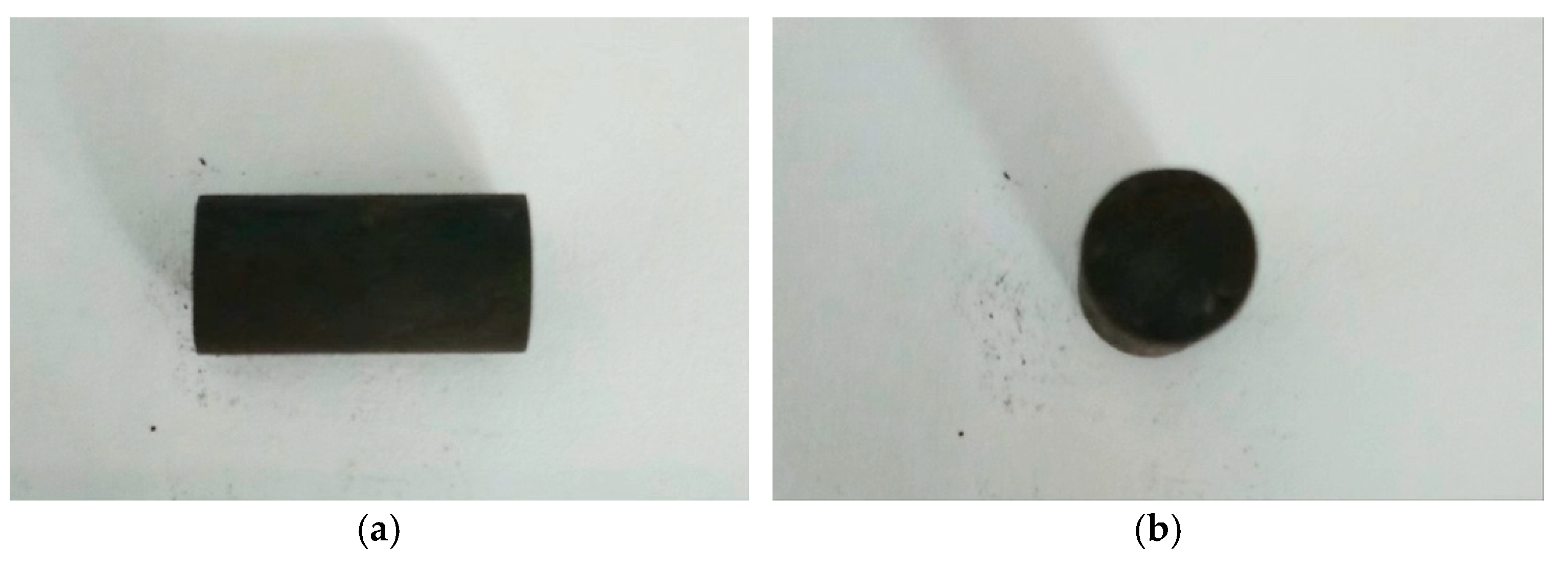
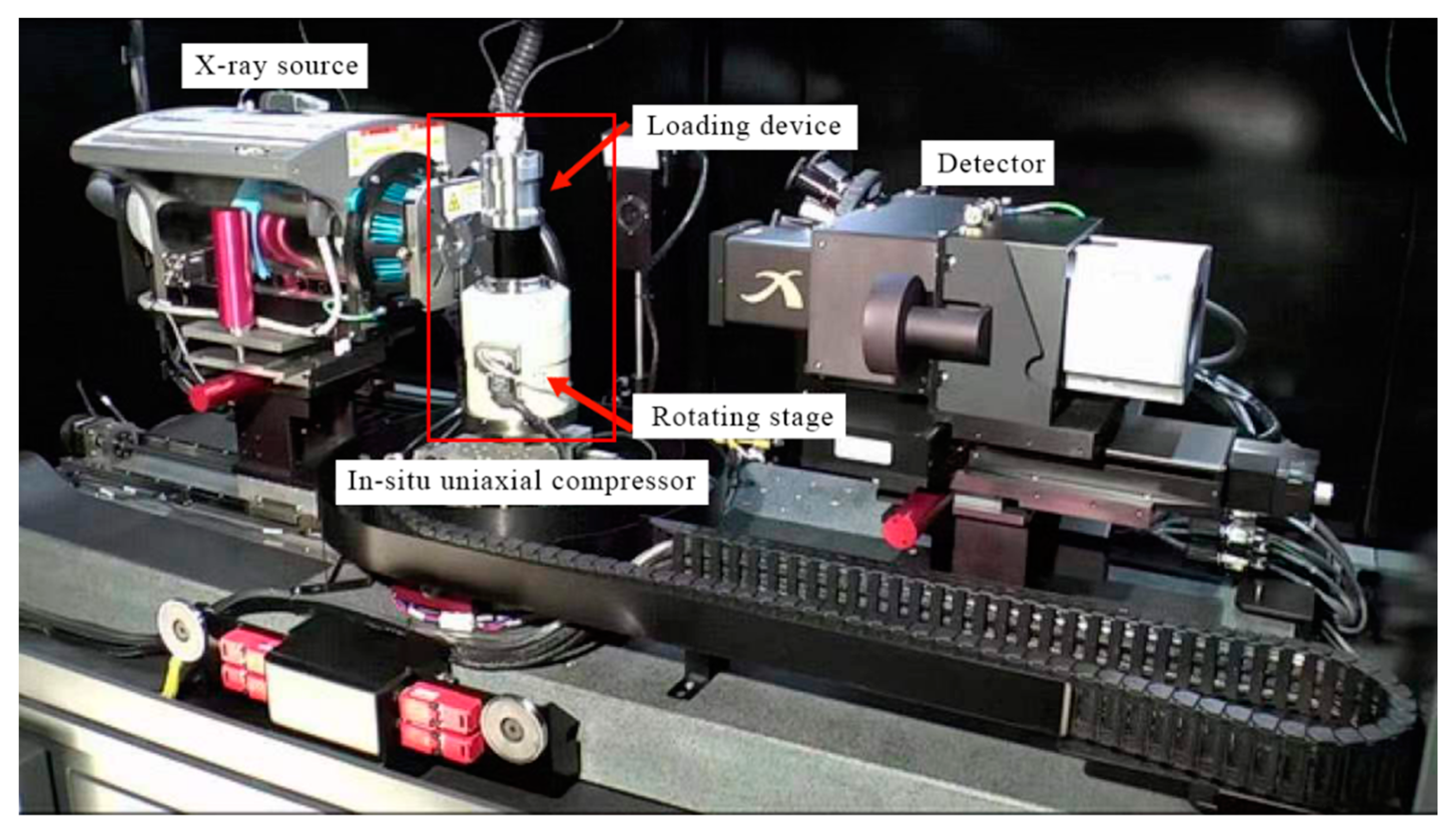

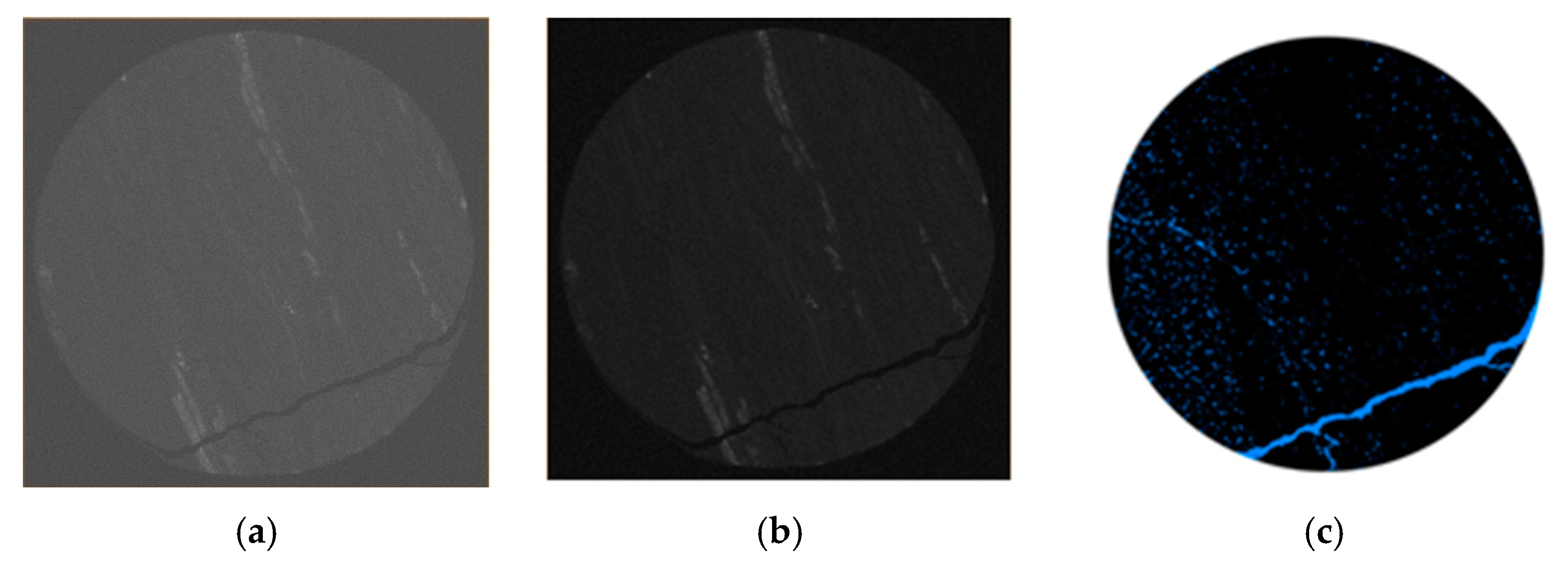


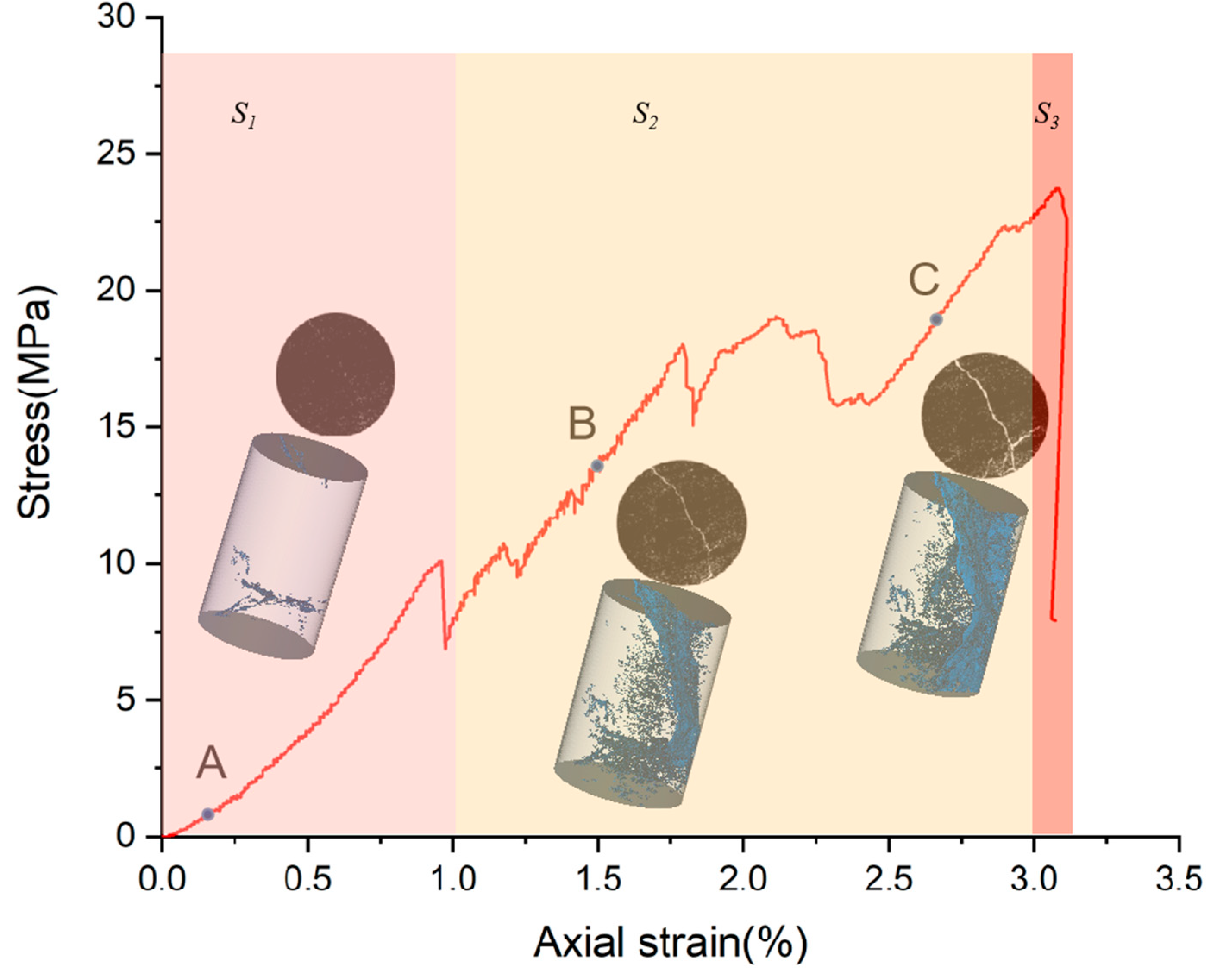

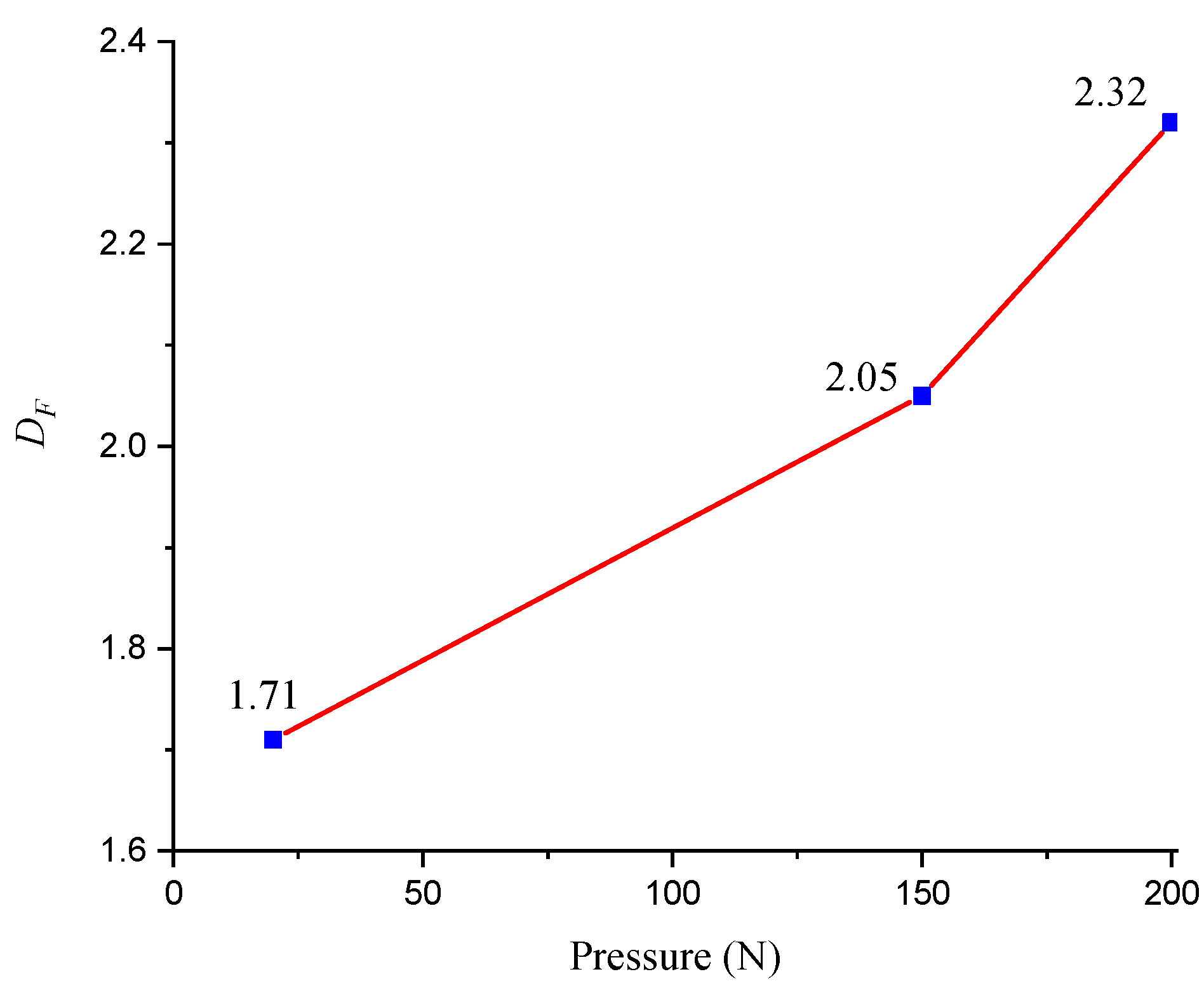

| Ro, max (%) | Macerals Composition (%) | Industrial Components (%) | ||||||
|---|---|---|---|---|---|---|---|---|
| Vitrinite | Inertinite | Clay Mineral | Sulfide Mineral | Mad | Vad | Aad | FCad | |
| 1.5 | 58 | 40.2 | 1.4 | 0.4 | 0.6 | 18.8 | 4.17 | 77.03 |
Disclaimer/Publisher’s Note: The statements, opinions and data contained in all publications are solely those of the individual author(s) and contributor(s) and not of MDPI and/or the editor(s). MDPI and/or the editor(s) disclaim responsibility for any injury to people or property resulting from any ideas, methods, instructions or products referred to in the content. |
© 2023 by the authors. Licensee MDPI, Basel, Switzerland. This article is an open access article distributed under the terms and conditions of the Creative Commons Attribution (CC BY) license (https://creativecommons.org/licenses/by/4.0/).
Share and Cite
Zhu, Y.; Tan, Y.; Zhang, S.; Wang, M.; Wang, B. Dynamic Evolution and Quantitative Characterization of Fractures in Coal at the Eastern Edge of Ordos Basin under Axial Loading. Processes 2023, 11, 1631. https://doi.org/10.3390/pr11061631
Zhu Y, Tan Y, Zhang S, Wang M, Wang B. Dynamic Evolution and Quantitative Characterization of Fractures in Coal at the Eastern Edge of Ordos Basin under Axial Loading. Processes. 2023; 11(6):1631. https://doi.org/10.3390/pr11061631
Chicago/Turabian StyleZhu, Yinghao, Yineng Tan, Songhang Zhang, Mengdie Wang, and Bingyi Wang. 2023. "Dynamic Evolution and Quantitative Characterization of Fractures in Coal at the Eastern Edge of Ordos Basin under Axial Loading" Processes 11, no. 6: 1631. https://doi.org/10.3390/pr11061631
APA StyleZhu, Y., Tan, Y., Zhang, S., Wang, M., & Wang, B. (2023). Dynamic Evolution and Quantitative Characterization of Fractures in Coal at the Eastern Edge of Ordos Basin under Axial Loading. Processes, 11(6), 1631. https://doi.org/10.3390/pr11061631








